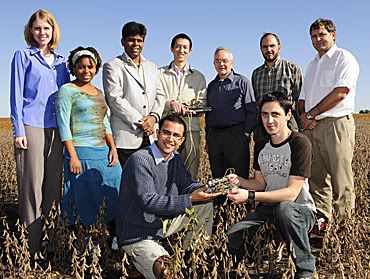Forest peoples' rights key to reducing emissions from deforestation - high risk of backlash

The experts are gathering in Oslo with policymakers and community leaders for a conference on rights, forests and climate change. The conference was organized by two non-profits, Rainforest Foundation Norway and the US-based Rights and Resources Initiative (RRI).
Speaking at the meeting, Norway's Minister of Environment and International Development, Erik Solheim, says efforts towards reduced emissions from deforestation in developing countries should be based on the rights of indigenous peoples to the forests they depend on for their livelihoods, and provide tangible benefits consistent with their essential role in sustainable forest management.
In addition to reducing emissions from deforestation and forest degradation [REDD], early action, pilot projects and demonstrations should safeguard biodiversity, contribute to poverty reduction and secure the rights of forest dependent communities in order to achieve any degree of permanence, legitimacy and effectiveness. - Erik SolheimDeforestation is responsible for about 20 percent of global greenhouse gas emissions, and reducing it is seen as one of the most straightforward ways of cutting emissions. But if care is not taken, new initiatives to reduce deforestation could even make matters worse.
Moves to finance reductions in tropical deforestation and forest degradation are necessary and welcome. But on their own they won't solve the problem. Poorly devised, they could even make it worse. If such initiatives are well designed they can not only secure carbon but present a global opportunity to address the underlying causes of poverty and conflict in many developing countries. - Andy White, Coordinator of RRIGlobally, climate change negotiators are considering the introduction of a new financial mechanism, known as Reduced Emissions from Deforestation and Forest Degradation (REDD), that could generate billions of dollars for reducing forest loss in the tropics. Meanwhile, the Government of Norway has already pledged up to 3 billion Norwegian kroner annually (US$ 500 million) to cut emissions from deforestation and forest degradation in tropical countries:
To achieve long-term reductions in deforestation and forest degradation, it is absolutely necessary to respect and strengthen the rights of indigenous and other forest dependent communities. Many of these schemes are still being developed, and major decisions on how to spend the money will be made in the next few years. For us, the question is whether this money will result in a great deal of good or a great deal of harm to the environment and forest communities. - Lars Løvold, director of Rainforest Foundation NorwayPrevious attempts to reduce deforestation and forest degradation have largely failed, often due to a lack of attention to human rights, property rights and transparency:
 energy :: sustainability :: biomass :: carbon sequestration :: deforestation :: biodiversity :: ecosystem services :: land tenure :: land grab :: corruption :: civil conflict :: carbon market ::
energy :: sustainability :: biomass :: carbon sequestration :: deforestation :: biodiversity :: ecosystem services :: land tenure :: land grab :: corruption :: civil conflict :: carbon market :: There are growing conflicts between indigenous peoples and both forestry companies and conservation organizations. Imposed forest management initiatives are only viable if they respect the customary rights of forest peoples and ensure they have control about what happens on their lands. Indigenous peoples must be accepted as full and fair participants in all climate negotiations. - Joji Carino, Director of TEBTEBBA, the Indigenous Peoples' International Center for Policy Research and EducationConference organizers worry that REDD could fuel corruption and provoke tensions and land grab situations unless good governance, policies and the rule of law are first put in place.
Indigenous peoples are rightly concerned about how these new investments could affect their access to the forests that they depend on for their livelihoods. This is precisely why we are fully supportive of a role for indigenous peoples and other forest dependent communities in the development and monitoring of climate plans and investments at the national and global level. These rights need to be respected, not just for moral reasons, although that is vital. It is also a matter of pragmatism and effectiveness. - Erik SolheimExperience from Brazil, the country in the world with the most advanced monitoring of its forests, gives valuable insight to the discussion on how forests can be protected. According to research from the Brazilian NGO Instituto Socioambiental, 19 percent of unprotected forest areas in Brazil have been deforested, while deforestation inside federal national parks is 2 percent. In indigenous territories, however, only 1.1 percent have been deforested.
The Oslo conference will discuss the Four Foundations for Effective Investments in Climate Change:
- Recognize rights - establish an equitable legal and regulatory framework for land and resources.
- Prioritize payment to communities – ensure that benefits and payments prioritize indigenous and local communities, according to their potential role as forest stewards.
- Establish independent advisory and auditing processes to guide, monitor and audit investments and actions at national and global levels.
- Monitor more than carbon to keep track of the status of forests, forest carbon, biodiversity and impacts on rights and livelihoods. Secure a role for indigenous peoples in monitoring of emissions, making full use of their knowledge of the state of forest ecosystems, something which could be particularly relevant to keep track of forest degradation.
A new study by RRI and Intercooperation, a Swiss development organization, finds that the average direct cost to legally recognize traditional community tenure rights is around $3 per hectare – an insignificant investment to make when the minimum estimates needed to pay for elements of a global REDD scheme are somewhere between $800 and $3500 per hectare each year for the next 22 years.
Another study that will be released at the conference, by Professor Arun Agrawal of the University of Michigan, uses data from 325 sites in 12 countries to show that community ownership of forests provides the best possibility for increasing carbon stocks and improving livelihood outcomes. This is the most robust research to date at a global scale on the relationship between forest tenure and carbon sequestration, livelihood benefits and biodiversity.
Agrawal's study also finds that the larger the property owned by communities, the better the chances for maintaining and sequestering carbon. This research shows the tremendous scope for cost-effective investments that strengthen local land rights, reduce poverty and conflict, and protect remaining natural forest areas.
To help ensure effective investments to combat in climate change, Rainforest Foundation Norway and RRI have called for the formation of independent bodies to advise and monitor the UN Convention on Climate Change.
Major decisions on REDD, as well as other measures to combat climate change, are likely to be made at the 15th Conference of the UN Convention on Climate Change, which will be held in Copenhagen, Denmark, in 2009.
In the next fifteen months, the world will have to make a choice. We can continue to ignore the legitimate rights of forest dwellers, which will exacerbate conflict in forests and make REDD ineffective. Or we can learn from the lessons of the past, recognize the property and human rights of forest dwellers, and almost immediately start reaping the benefits. - Lars LøvoldThe mission of the Rainforest Foundation is to support indigenous peoples and traditional populations of the world's rainforests in their efforts to protect their environment and fulfill their rights by assisting them in: securing and controlling the natural resources necessary for their long-term well-being and managing these resources in ways which do not harm their environment, violate their culture or compromise their future; and developing the means to protect their individual and collective rights and to obtain, shape, and control basic services from the state.
The Rights and Resources Initiative (RRI) in a new coalition of organisations dedicated to raising global awareness of the critical need for forest tenure, policy and market reforms, in order to achieve global goals of poverty alleviation, biodiversity conservation and forest-based economic growth. Partners currently include ACICAFOC (Coordinating Association of Indigenous and Agroforestry Communities of Central America), the Center for International Forestry Research (CIFOR), Civic Response, the Foundation for People and Community Development (FPCD), Forest Peoples Programme, Forest Trends, the World Agroforestry Center (ICRAF), Intercooperation, the World Conservation Union (IUCN), the Federation of Community Forest Organisations of Nepal (FECOFUN), and the Regional Community Forestry Training Center for Asia and the Pacific (RECOFTC).
References:
Interested readers can find background information and follow the Oslo conference discussions, here.
RRI: Beyond Tenure: Rights-Based Approaches to People and Forests - Some lessons from the Forest Peoples Programme - July 2008.
Article continues
 --------------
--------------
 Mongabay, a leading resource for news and perspectives on environmental and conservation issues related to the tropics, has launched Tropical Conservation Science - a new, open access academic e-journal. It will cover a wide variety of scientific and social studies on tropical ecosystems, their biodiversity and the threats posed to them.
Mongabay, a leading resource for news and perspectives on environmental and conservation issues related to the tropics, has launched Tropical Conservation Science - a new, open access academic e-journal. It will cover a wide variety of scientific and social studies on tropical ecosystems, their biodiversity and the threats posed to them.


 Healthy soils and their efficient management are key to any society's long-term survival. Soils cycle carbon, nitrogen, nutrients and help produce energy in the form of biomass. But there is only a handful of soil scientists around who can help us make the most of this important natural resource. In fact, a lot damage can be done to soils by non-experts working them on a daily basis. And many land-use decisions would be changed if knowledge about soils was put into practise more often. Some basic soil science techniques and skills can be learned by anyone willing to put in some effort, though. An interesting article in the
Healthy soils and their efficient management are key to any society's long-term survival. Soils cycle carbon, nitrogen, nutrients and help produce energy in the form of biomass. But there is only a handful of soil scientists around who can help us make the most of this important natural resource. In fact, a lot damage can be done to soils by non-experts working them on a daily basis. And many land-use decisions would be changed if knowledge about soils was put into practise more often. Some basic soil science techniques and skills can be learned by anyone willing to put in some effort, though. An interesting article in the 


 Stuart Birrell, an Iowa State associate professor of agricultural and biosystems engineering and a part of the sensor research team, said the project will provide the kind of real-time, high-resolution data that researchers and producers have been looking for:
Stuart Birrell, an Iowa State associate professor of agricultural and biosystems engineering and a part of the sensor research team, said the project will provide the kind of real-time, high-resolution data that researchers and producers have been looking for:






Friday, October 17, 2008
UN Foundation report: Bioenergy can lift West-Africa out of poverty
According to the report, key factors to guide sustainable bioenergy include improving agriculture and forest productivity, and protecting watersheds, which would also put governments in a better position to fight against climate change and cope with inevitable impacts. Traditional wood biomass production – 73% of primary energy used in the region – must be adapted to create more efficient and cleaner fuel.
Bioenergy can be transformative for the region – greatly expanding electricity and energy access, creating more jobs and better income in rural communities and growth across national and regional economies:
Innovative crop management, farmer training, and consistent investment are needed to improve agriculture productivity in this region. Land use, protection of small producers, infrastructure improvement, data collection, and women’s roles are some of the critical points which must be taken into account by governments in order to secure sustainability, the report found.
The United Nations Foundation is an advocate for the UN and a platform for connecting people, ideas and capital to help the United Nations solve global problems. We build partnerships, grow constituencies, mobilize resources and advocate policy changes to support the UN’s work for individual and global progress. The UN Foundation’s work — focused on select global problems — is decreasing child mortality, improving disaster relief, protecting diverse cultures and environments, creating a clean energy future, empowering women and girls, and improving U.S.-UN relations. The UN Foundation is a public charity.
The International Centre for Trade and Sustainable Development (ICTSD) was established in Geneva in September 1996 to contribute to a better understanding of development and environment concerns in the context of international trade. As an independent non-profit and non-governmental organisation, ICTSD engages a broad range of actors in ongoing dialogue about trade and sustainable development. With a wide network of governmental, non-governmental and inter-governmental partners, ICTSD plays a unique systemic role as a provider of original, non-partisan reporting and facilitation services at the intersection of international trade and sustainable development.
The Rural Hub for Western and Central Africa is a non-governmental organization whose goal is to assist West and Central African stakeholders (States, Inter-governmental Organisations, Civil Society Organisations and Development Partners) to promote coherence in rural development programmes worldwide.
References:
UN Foundation: Sustainable Bioenergy Development in UEMOA Member Countries - October 2008 [separate chapters in *.pdf format - full report in one *.pdf file, here].
Article continues
posted by Biopact team at 2:01 PM 1 comments links to this post
